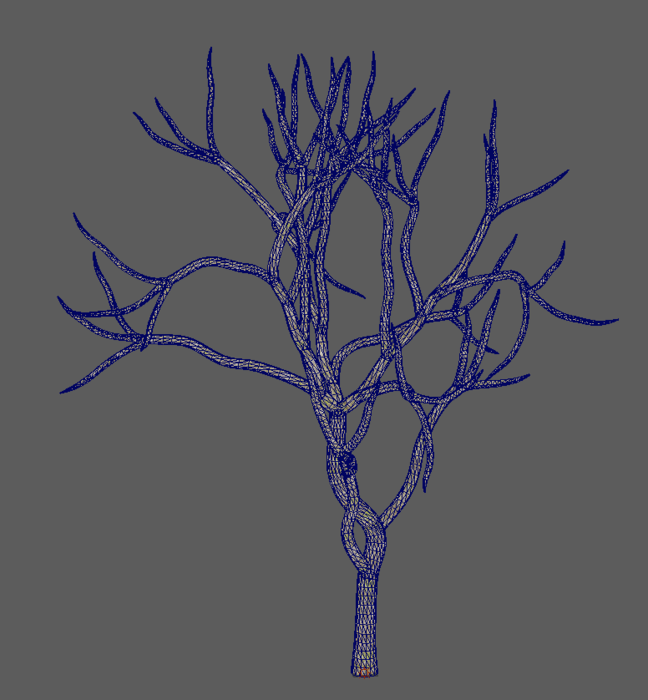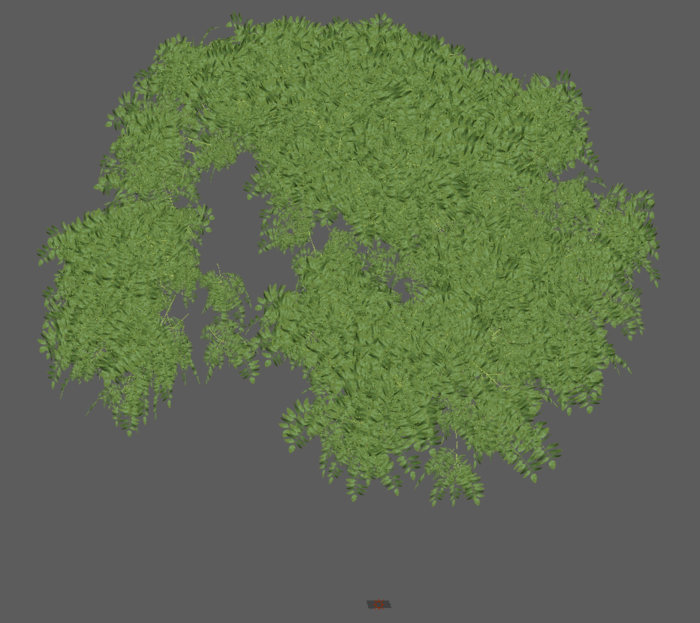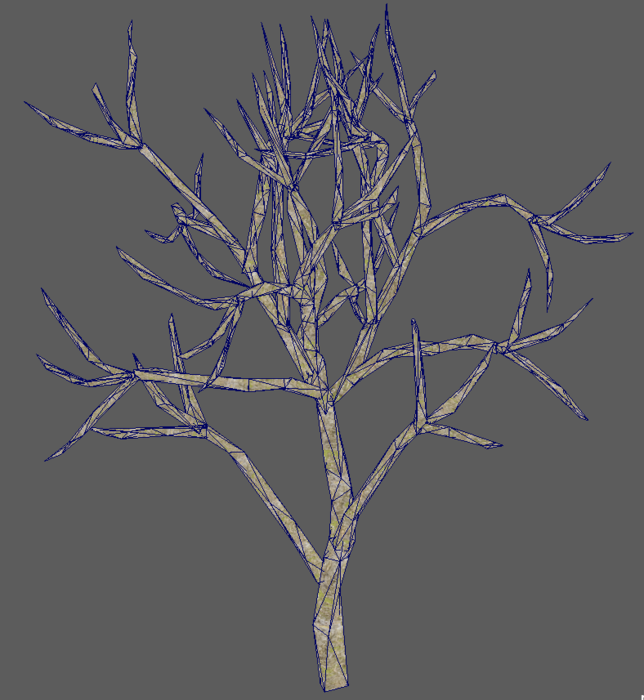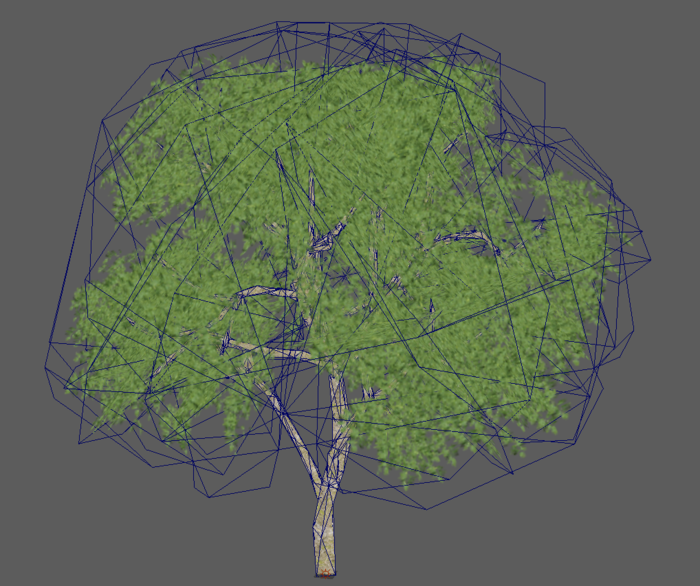Manually separate trunk during vegetation optimization
Written by Jesper Tingvall, Product Expert, Simplygon
Disclaimer: The code in this post is written using version 9.2.4200.0 of Simplygon and Maya 2022. If you encounter this post at a later stage, some of the API calls might have changed. However, the core concepts should still remain valid.
Introduction
Simplygon has a pipeline specific tailored for vegetation optimization; Billboard Cloud for Vegetation. One of its features is an automatic trunk detector which can separate out the trunk from all leaves and run it in a separate reduction processor. However for this blog post we are going to do that manually to increase our control over the processing.

Prerequisites
This example will use the Simplygon integration in Maya, but the same concepts can be applied to all other integrations of the Simplygon API.
Problem to solve
We want to optimize a vegetation asset using the billboard cloud for vegetation pipeline. However we want to have more control over what is counted as trunk and what is counted as leaves. One reason for this could be that it is hard to find seperation values that works for all of our assets.
Solution
The solution is to manually split the asset into two parts; leaves and trunk. We can then process those parts seperate using the pipelines we want.
Export selection
First we are going to export selection from Maya into a temporary file.
tmp_file = "c:/Temp/export.sb"
def export_selection(sg):
"""Export the current selected objects into a Simplygon scene."""
cmds.Simplygon(exp = tmp_file)
scene = sg.CreateScene()
scene.LoadFromFile(tmp_file)
return scene
Split tree
The asset will be split into two different different Selection Sets; one for the trunk and one for leaves and tiny branches.
# Split scene into 2 selection sets; leaves and trunk
leaf_set = sg.CreateSelectionSet()
trunk_set = sg.CreateSelectionSet()
leaf_set_id = scene.GetSelectionSetTable().AddSelectionSet(leaf_set)
trunk_set_id = scene.GetSelectionSetTable().AddSelectionSet(trunk_set)
split_tree(scene, scene.GetRootNode(), leaf_set, trunk_set)
We will split the scene recursively into the two sets depending on if the node is considered to be part of the trunk or not.
def split_tree(scene, scene_node, leaf_set, trunk_set):
"""Splits scene_node recursively into two sets; leaf_set and trunk set."""
for i in range(0, scene_node.GetChildCount()):
child = scene_node.GetChild(i)
if child.IsA("ISceneMesh"):
scene_mesh = Simplygon.spSceneMesh.SafeCast(child)
if is_mesh_trunk(scene, scene_mesh):
trunk_set.AddItem(child.GetNodeGUID())
else:
leaf_set.AddItem(child.GetNodeGUID())
split_tree(scene, child, leaf_set, trunk_set)
Detect trunk
There is a lot of ways to detect if a mesh is part of the trunk or leaves. One way of doing it could be to check if it is transparent or not as we do in this blog post. Another way would be to check if the model contains a material with a specific name. In this assets case however we are going to use the most basic case; the name of the mesh.

An inspection of the asset reveals that the part we want to process with the reducer contains Trunk. Branches and leaves should be processed with the billboard cloud processor.
def is_mesh_trunk(scene, scene_mesh):
"""Returns True if scene_mesh is trunk or False if it is leaves."""
return "trunk" in scene_mesh.GetName().lower()
After splitting the scene here is the trunk.

And here are the leaves including small branches.

Reduce trunk pipeline
The trunk will be reduced using a reduction pipeline. We are going to use triangle ratio as target.
def create_reduction_pipeline(sg, set_id):
"""Returns a reduction pipeline for trunk"""
pipeline = sg.CreateReductionPipeline()
pipeline_settings = pipeline.GetReductionSettings()
pipeline_settings.SetReductionTargetTriangleRatio(0.10)
pipeline_settings.SetReductionTargetTriangleRatioEnabled(True)
return pipeline
After processing this is the resulting trunk.

Billboard cloud for leaves pipeline
For leaves and tiny branches we are going to use Billboard Cloud for vegetation pipeline. We set SetSeparateTrunkAndFoilage to False since we are separating it manually.
def create_billboard_cloud_pipeline(sg, set_id):
"""Returns a billboard cloud for vegetation pipeline for leaves and tiny branches"""
# Create the Impostor processor.
sgBillboardCloudVegetationPipeline = sg.CreateBillboardCloudVegetationPipeline()
sgBillboardCloudSettings = sgBillboardCloudVegetationPipeline.GetBillboardCloudSettings()
sgMappingImageSettings = sgBillboardCloudVegetationPipeline.GetMappingImageSettings()
sgMappingImageSettings.SetTexCoordName("MaterialLOD") # Needs to be set for Maya.
# Set billboard cloud mode to Foliage and settings.
sgBillboardCloudSettings.SetBillboardMode( Simplygon.EBillboardMode_Foliage )
sgBillboardCloudSettings.SetBillboardDensity( 0.4 )
sgBillboardCloudSettings.SetGeometricComplexity( 0.5 )
sgBillboardCloudSettings.SetMaxPlaneCount( 10 )
sgBillboardCloudSettings.SetTwoSided( True )
sgFoliageSettings = sgBillboardCloudSettings.GetFoliageSettings()
# Do not seperate Trunk and Foilage.
sgFoliageSettings.SetSeparateTrunkAndFoliage( False )
# Setting the size of the output material for the mapping image.
sgMappingImageSettings.SetMaximumLayers( 3 )
sgOutputMaterialSettings = sgMappingImageSettings.GetOutputMaterialSettings(0)
sgOutputMaterialSettings.SetTextureWidth( 1024 )
sgOutputMaterialSettings.SetTextureHeight( 1024 )
sgOutputMaterialSettings.SetMultisamplingLevel( 2 )
Firstly we are going to add a Color Caster for the diffuse channel and set Maya specific settings. One thing to look out for in particular is SetOutputSRGB. If your casted texture differs a little bit in color from the original it is quite likely it is incorrect.
# Add diffuse material caster to pipeline and set up with Maya material settings.
print("Add diffuse material caster to pipeline.")
sgDiffuseCaster = sg.CreateColorCaster()
sgDiffuseCasterSettings = sgDiffuseCaster.GetColorCasterSettings()
sgDiffuseCasterSettings.SetMaterialChannel( "color" )
sgDiffuseCasterSettings.SetOutputImageFileFormat( Simplygon.EImageOutputFormat_PNG )
sgDiffuseCasterSettings.SetBakeOpacityInAlpha( False )
sgDiffuseCasterSettings.SetOutputPixelFormat( Simplygon.EPixelFormat_R8G8B8 )
sgDiffuseCasterSettings.SetDilation( 10 )
sgDiffuseCasterSettings.SetFillMode( Simplygon.EAtlasFillMode_Interpolate )
sgDiffuseCasterSettings.SetUseMultisampling(True)
sgDiffuseCasterSettings.SetOutputSRGB(True)
sgDiffuseCasterSettings.SetOpacityChannel("transparency")
sgBillboardCloudVegetationPipeline.AddMaterialCaster( sgDiffuseCaster, 0 )
We add a Color Caster for the specular channel and add Maya specific settings.
# Add specular material caster to pipeline and set up with Maya material settings.
print("Add specular material caster to pipeline.")
sgSpecularCaster = sg.CreateColorCaster()
sgSpecularCasterSettings = sgSpecularCaster.GetColorCasterSettings()
sgSpecularCasterSettings.SetMaterialChannel( "specularColor" )
sgSpecularCasterSettings.SetOutputImageFileFormat( Simplygon.EImageOutputFormat_PNG )
sgSpecularCasterSettings.SetDilation( 0 )
sgSpecularCasterSettings.SetFillMode( Simplygon.EAtlasFillMode_NoFill)
sgSpecularCasterSettings.SetOpacityChannel("transparency")
sgBillboardCloudVegetationPipeline.AddMaterialCaster( sgSpecularCaster, 0 )
We add a Normal Caster so we can bake a normal map for the leaves and set corresponding Maya settings.
# Add normals material caster to pipeline and set up with Maya material settings.
print("Add normals material caster to pipeline.")
sgNormalsCaster = sg.CreateNormalCaster()
sgNormalsCasterSettings = sgNormalsCaster.GetNormalCasterSettings()
sgNormalsCasterSettings.SetMaterialChannel( "normalCamera" )
sgNormalsCasterSettings.SetGenerateTangentSpaceNormals( True )
sgNormalsCasterSettings.SetOutputImageFileFormat( Simplygon.EImageOutputFormat_PNG )
sgNormalsCasterSettings.SetDilation( 10 )
sgNormalsCasterSettings.SetFillMode( Simplygon.EAtlasFillMode_Interpolate )
sgBillboardCloudVegetationPipeline.AddMaterialCaster( sgNormalsCaster, 0 )
Lastly we are going to add an Opacity Caster for casting the transparency and set it up for Maya.
# Add opacity material casting to pipelineand set up with Maya material settings.
print("Add opacity material casting to pipeline.")
sgOpacityCaster = sg.CreateOpacityCaster()
sgOpacityCasterSettings = sgOpacityCaster.GetOpacityCasterSettings()
sgOpacityCasterSettings.SetMaterialChannel( "transparency" )
sgOpacityCasterSettings.SetOpacityChannel("transparency")
sgOpacityCasterSettings.SetOutputImageFileFormat( Simplygon.EImageOutputFormat_PNG )
sgOpacityCasterSettings.SetFillMode( Simplygon.EAtlasFillMode_NoFill )
sgOpacityCasterSettings.SetDilation( 0 )
sgOpacityCasterSettings.SetUseMultisampling(True)
sgOpacityCasterSettings.SetOutputPixelFormat( Simplygon.EPixelFormat_R8 )
sgOpacityCasterSettings.SetOpacityChannelComponent(Simplygon.EColorComponent_Red)
sgOpacityCasterSettings.SetOutputOpacityType(Simplygon.EOpacityType_Opacity)
sgOpacityCasterSettings.SetOutputSRGB(False)
sgBillboardCloudVegetationPipeline.AddMaterialCaster( sgOpacityCaster, 0 )
return sgBillboardCloudVegetationPipeline
After processing this is the resulting leaves and small branches scene.

Putting it all together
We start by exporting the selected asset from Maya and splitting it up into our two selection sets; leaf_set and trunk_set.
def process_selection(sg):
"""Optimize Maya selected vegetation asset."""
# Set tangent space for Maya
sg.SetGlobalDefaultTangentCalculatorTypeSetting(Simplygon.ETangentSpaceMethod_MikkTSpace)
scene = export_selection(sg)
# Split scene into 2 selection sets; leaves and trunk
leaf_set = sg.CreateSelectionSet()
trunk_set = sg.CreateSelectionSet()
leaf_set_id = scene.GetSelectionSetTable().AddSelectionSet(leaf_set)
trunk_set_id = scene.GetSelectionSetTable().AddSelectionSet(trunk_set)
split_tree(scene, scene.GetRootNode(), leaf_set, trunk_set)
Only process parts of a scene via selection sets is not supported by the Billboard Cloud pipeline. Hence we are going to create a clone of the scene. Then we are going to remove the trunk and leaves from each scene via RemoveSceneNodesInSelectionSet. The result is two scenes; one with trunk and one with leaves and tiny branches.
# Create a scene containing only the leaves
leaf_scene = scene.NewCopy()
leaf_scene.RemoveSceneNodesInSelectionSet(trunk_set_id)
# Remove all leaves from original scene so we are left with only trunk
scene.RemoveSceneNodesInSelectionSet(leaf_set_id)
We process our trunk scene using our reduction pipeline and our leaf scene using out billboard cloud for vegetation pipeline.
# Process trunk
reduction_pipeline = create_reduction_pipeline(sg, 0)
reduction_pipeline.RunScene(scene, Simplygon.EPipelineRunMode_RunInThisProcess)
# Process leaves
leaf_pipeline = create_billboard_cloud_pipeline(sg, 0)
leaf_pipeline.RunScene(leaf_scene, Simplygon.EPipelineRunMode_RunInThisProcess)
Lastly we are going to merge the two processed scenes together using Append which copies over everything from leaf_scene into scene.
# Add processed leaves scene to processed trunk scene
scene.Append(leaf_scene)
# Export to Maya
import_results(scene)
Import selection
When all processing is done we are going to import it into Maya again. We use LinkMaterials flag. It links the materials to the old ones in Maya. Otherwise would our Tree trunk get a new material and not share material with original asset.
def import_results(scene):
"""Import the Simplygon scene into Maya."""
scene.SaveToFile(tmp_file)
cmds.Simplygon(imp=tmp_file, lma=True)
Result
The result is a highly optimized tree and we have total control over which parts that are reduced or turned into a billboard.

| Asset | Verts | Materials |
|---|---|---|
| Original asset | 197 872 | 4 |
| Optimized asset | 1 144 | 2 |
One benefit of this approach is that we can process the trunk with another pipeline if we want to. We also get access to more options in the reduction pipeline
Complete script
# Copyright (c) Microsoft Corporation.
# Licensed under the MIT license.
from simplygon import simplygon_loader
from simplygon import Simplygon
import maya.cmds as cmds
import os
tmp_file = "c:/Temp/export.sb"
def export_selection(sg):
"""Export the current selected objects into a Simplygon scene."""
cmds.Simplygon(exp = tmp_file)
scene = sg.CreateScene()
scene.LoadFromFile(tmp_file)
return scene
def import_results(scene):
"""Import the Simplygon scene into Maya."""
scene.SaveToFile(tmp_file)
cmds.Simplygon(imp=tmp_file, lma=True)
def split_tree(scene, scene_node, leaf_set, trunk_set):
"""Splits scene_node recursively into two sets; leaf_set and trunk set."""
for i in range(0, scene_node.GetChildCount()):
child = scene_node.GetChild(i)
if child.IsA("ISceneMesh"):
scene_mesh = Simplygon.spSceneMesh.SafeCast(child)
if is_mesh_trunk(scene, scene_mesh):
trunk_set.AddItem(child.GetNodeGUID())
else:
leaf_set.AddItem(child.GetNodeGUID())
split_tree(scene, child, leaf_set, trunk_set)
def is_mesh_trunk(scene, scene_mesh):
"""Returns True if scene_mesh is trunk or False if it is leaves."""
return "trunk" in scene_mesh.GetName().lower()
def create_reduction_pipeline(sg, set_id):
"""Returns a reduction pipeline for trunk"""
pipeline = sg.CreateReductionPipeline()
pipeline_settings = pipeline.GetReductionSettings()
pipeline_settings.SetReductionTargetTriangleRatio(0.10)
pipeline_settings.SetReductionTargetTriangleRatioEnabled(True)
return pipeline
def create_billboard_cloud_pipeline(sg, set_id):
"""Returns a billboard cloud for vegetation pipeline for leaves and tiny branches"""
# Create the Impostor processor.
sgBillboardCloudVegetationPipeline = sg.CreateBillboardCloudVegetationPipeline()
sgBillboardCloudSettings = sgBillboardCloudVegetationPipeline.GetBillboardCloudSettings()
sgMappingImageSettings = sgBillboardCloudVegetationPipeline.GetMappingImageSettings()
sgMappingImageSettings.SetTexCoordName("MaterialLOD") # Needs to be set for Maya.
# Set billboard cloud mode to Foliage and settings.
sgBillboardCloudSettings.SetBillboardMode( Simplygon.EBillboardMode_Foliage )
sgBillboardCloudSettings.SetBillboardDensity( 0.4 )
sgBillboardCloudSettings.SetGeometricComplexity( 0.5 )
sgBillboardCloudSettings.SetMaxPlaneCount( 10 )
sgBillboardCloudSettings.SetTwoSided( True )
sgFoliageSettings = sgBillboardCloudSettings.GetFoliageSettings()
# Do not seperate Trunk and Foilage.
sgFoliageSettings.SetSeparateTrunkAndFoliage( False )
# Setting the size of the output material for the mapping image.
sgMappingImageSettings.SetMaximumLayers( 3 )
sgOutputMaterialSettings = sgMappingImageSettings.GetOutputMaterialSettings(0)
sgOutputMaterialSettings.SetTextureWidth( 1024 )
sgOutputMaterialSettings.SetTextureHeight( 1024 )
sgOutputMaterialSettings.SetMultisamplingLevel( 2 )
# Add diffuse material caster to pipeline and set up with Maya material settings.
print("Add diffuse material caster to pipeline.")
sgDiffuseCaster = sg.CreateColorCaster()
sgDiffuseCasterSettings = sgDiffuseCaster.GetColorCasterSettings()
sgDiffuseCasterSettings.SetMaterialChannel( "color" )
sgDiffuseCasterSettings.SetOutputImageFileFormat( Simplygon.EImageOutputFormat_PNG )
sgDiffuseCasterSettings.SetBakeOpacityInAlpha( False )
sgDiffuseCasterSettings.SetOutputPixelFormat( Simplygon.EPixelFormat_R8G8B8 )
sgDiffuseCasterSettings.SetDilation( 10 )
sgDiffuseCasterSettings.SetFillMode( Simplygon.EAtlasFillMode_Interpolate )
sgDiffuseCasterSettings.SetUseMultisampling(True)
sgDiffuseCasterSettings.SetOutputSRGB(True)
sgDiffuseCasterSettings.SetOpacityChannel("transparency")
sgBillboardCloudVegetationPipeline.AddMaterialCaster( sgDiffuseCaster, 0 )
# Add specular material caster to pipeline and set up with Maya material settings.
print("Add specular material caster to pipeline.")
sgSpecularCaster = sg.CreateColorCaster()
sgSpecularCasterSettings = sgSpecularCaster.GetColorCasterSettings()
sgSpecularCasterSettings.SetMaterialChannel( "specularColor" )
sgSpecularCasterSettings.SetOutputImageFileFormat( Simplygon.EImageOutputFormat_PNG )
sgSpecularCasterSettings.SetDilation( 0 )
sgSpecularCasterSettings.SetFillMode( Simplygon.EAtlasFillMode_NoFill)
sgSpecularCasterSettings.SetOpacityChannel("transparency")
sgBillboardCloudVegetationPipeline.AddMaterialCaster( sgSpecularCaster, 0 )
# Add normals material caster to pipeline and set up with Maya material settings.
print("Add normals material caster to pipeline.")
sgNormalsCaster = sg.CreateNormalCaster()
sgNormalsCasterSettings = sgNormalsCaster.GetNormalCasterSettings()
sgNormalsCasterSettings.SetMaterialChannel( "normalCamera" )
sgNormalsCasterSettings.SetGenerateTangentSpaceNormals( True )
sgNormalsCasterSettings.SetOutputImageFileFormat( Simplygon.EImageOutputFormat_PNG )
sgNormalsCasterSettings.SetDilation( 10 )
sgNormalsCasterSettings.SetFillMode( Simplygon.EAtlasFillMode_Interpolate )
sgBillboardCloudVegetationPipeline.AddMaterialCaster( sgNormalsCaster, 0 )
# Add opacity material casting to pipelineand set up with Maya material settings.
print("Add opacity material casting to pipeline.")
sgOpacityCaster = sg.CreateOpacityCaster()
sgOpacityCasterSettings = sgOpacityCaster.GetOpacityCasterSettings()
sgOpacityCasterSettings.SetMaterialChannel( "transparency" )
sgOpacityCasterSettings.SetOpacityChannel("transparency")
sgOpacityCasterSettings.SetOutputImageFileFormat( Simplygon.EImageOutputFormat_PNG )
sgOpacityCasterSettings.SetFillMode( Simplygon.EAtlasFillMode_NoFill )
sgOpacityCasterSettings.SetDilation( 0 )
sgOpacityCasterSettings.SetUseMultisampling(True)
sgOpacityCasterSettings.SetOutputPixelFormat( Simplygon.EPixelFormat_R8 )
sgOpacityCasterSettings.SetOpacityChannelComponent(Simplygon.EColorComponent_Red)
sgOpacityCasterSettings.SetOutputOpacityType(Simplygon.EOpacityType_Opacity)
sgOpacityCasterSettings.SetOutputSRGB(False)
sgBillboardCloudVegetationPipeline.AddMaterialCaster( sgOpacityCaster, 0 )
return sgBillboardCloudVegetationPipeline
def process_selection(sg):
"""Optimize Maya selected vegetation asset."""
# Set tangent space for Maya
sg.SetGlobalDefaultTangentCalculatorTypeSetting(Simplygon.ETangentSpaceMethod_MikkTSpace)
scene = export_selection(sg)
# Split scene into 2 selection sets; leaves and trunk
leaf_set = sg.CreateSelectionSet()
trunk_set = sg.CreateSelectionSet()
leaf_set_id = scene.GetSelectionSetTable().AddSelectionSet(leaf_set)
trunk_set_id = scene.GetSelectionSetTable().AddSelectionSet(trunk_set)
split_tree(scene, scene.GetRootNode(), leaf_set, trunk_set)
# Create a scene containing only the leaves
leaf_scene = scene.NewCopy()
leaf_scene.RemoveSceneNodesInSelectionSet(trunk_set_id)
# Remove all leaves from original scene so we are left with only trunk
scene.RemoveSceneNodesInSelectionSet(leaf_set_id)
# Process trunk
reduction_pipeline = create_reduction_pipeline(sg, 0)
reduction_pipeline.RunScene(scene, Simplygon.EPipelineRunMode_RunInThisProcess)
# Process leaves
leaf_pipeline = create_billboard_cloud_pipeline(sg, 0)
leaf_pipeline.RunScene(leaf_scene, Simplygon.EPipelineRunMode_RunInThisProcess)
# Add processed leaves scene to processed trunk scene
scene.Append(leaf_scene)
# Export to Maya
import_results(scene)
def main():
sg = simplygon_loader.init_simplygon()
process_selection(sg)
del sg
if __name__== "__main__":
main()
